FNSCUS501: Develop and Nurture Relationships - IBM Australia
VerifiedAdded on 2023/06/09
|12
|3019
|182
Homework Assignment
AI Summary
This assignment solution for FNSCUS501 at the Institute of Business and Management Australia addresses the development and nurturing of relationships with clients, professionals, and third-party referrers. It covers key aspects such as maintaining confidentiality, outlining communication protocols, establishing and maintaining business relationships, implementing effective interpersonal communication, and applying cross-cultural communication strategies. The assignment also delves into the principles of negotiation, characteristics of effective negotiators, the concept of win-win negotiations, and factors contributing to successful negotiations. Furthermore, it discusses the purpose and benefits of a relationship management plan and examines the key requirements of Acts like the Age Discrimination Act, Disability Discrimination Act, Fair Work Act, Racial Discrimination Act, and Sex Discrimination Act, emphasizing their importance in relationship management. The assignment includes a client relationship project with a sample email for scheduling a meeting and a networking project outlining participation in a professional social network.
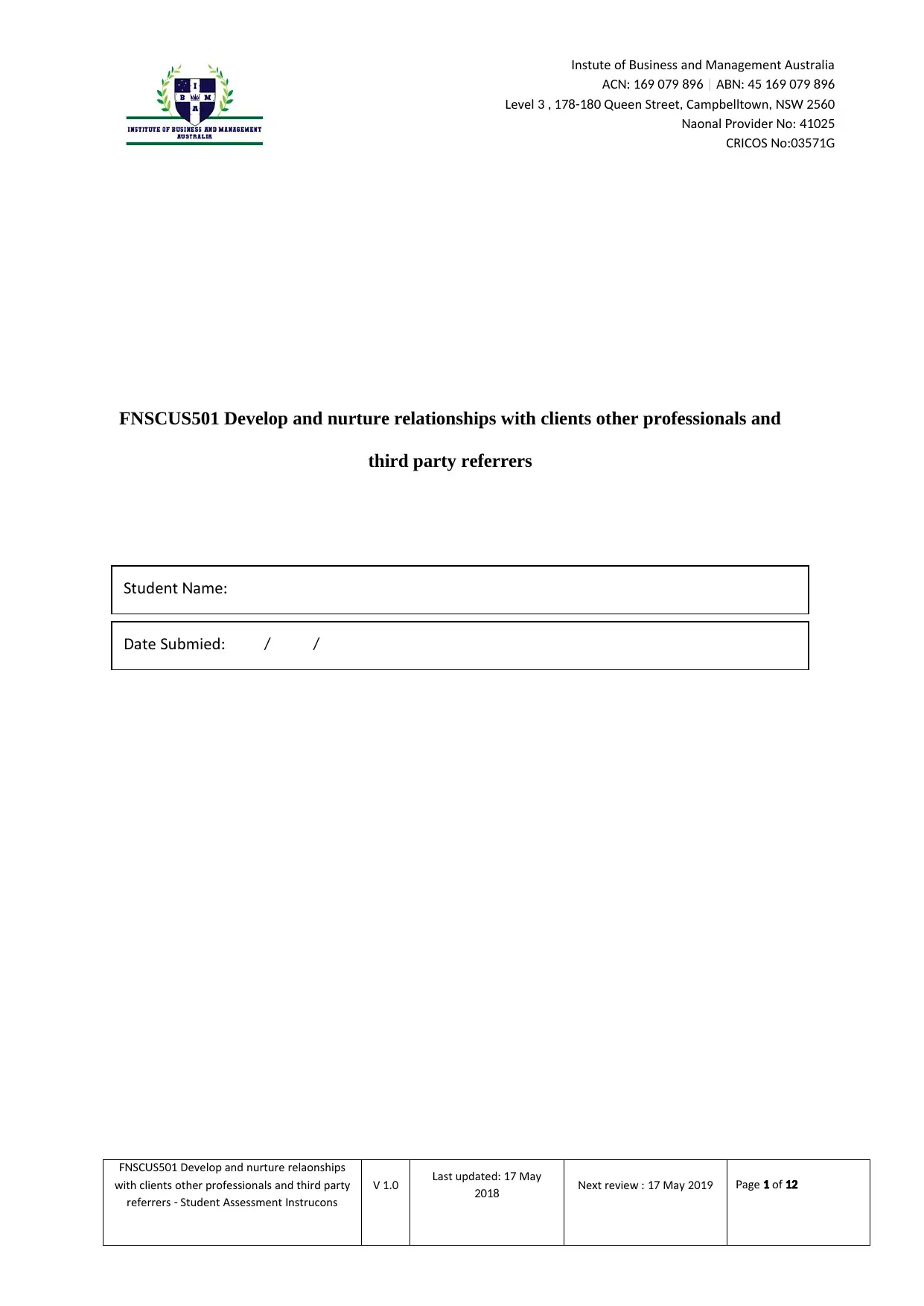
nstitute of usiness and Management AustraliaI B
ACN: 169 079 896 | ABN: 45 169 079 896
evel ueen Street Campbelltown SL 3 , 178-180 Q , , N W 2560
ational rovider oN P N : 41025
CR C S oI O N :03571G
FNSCUS501 Develop and nurture relationships with clients other professionals and
third party referrers
SC S Develop and nurture relationshipsFN U 501
with clients other professionals and third party
referrers Student Assessment nstructions- I
V 1.0 ast updated MayL : 17
2018 e t review MayN x : 17 2019 ageP 1 of 12
Date Submitted: / /
Student ameN :
ACN: 169 079 896 | ABN: 45 169 079 896
evel ueen Street Campbelltown SL 3 , 178-180 Q , , N W 2560
ational rovider oN P N : 41025
CR C S oI O N :03571G
FNSCUS501 Develop and nurture relationships with clients other professionals and
third party referrers
SC S Develop and nurture relationshipsFN U 501
with clients other professionals and third party
referrers Student Assessment nstructions- I
V 1.0 ast updated MayL : 17
2018 e t review MayN x : 17 2019 ageP 1 of 12
Date Submitted: / /
Student ameN :
Paraphrase This Document
Need a fresh take? Get an instant paraphrase of this document with our AI Paraphraser
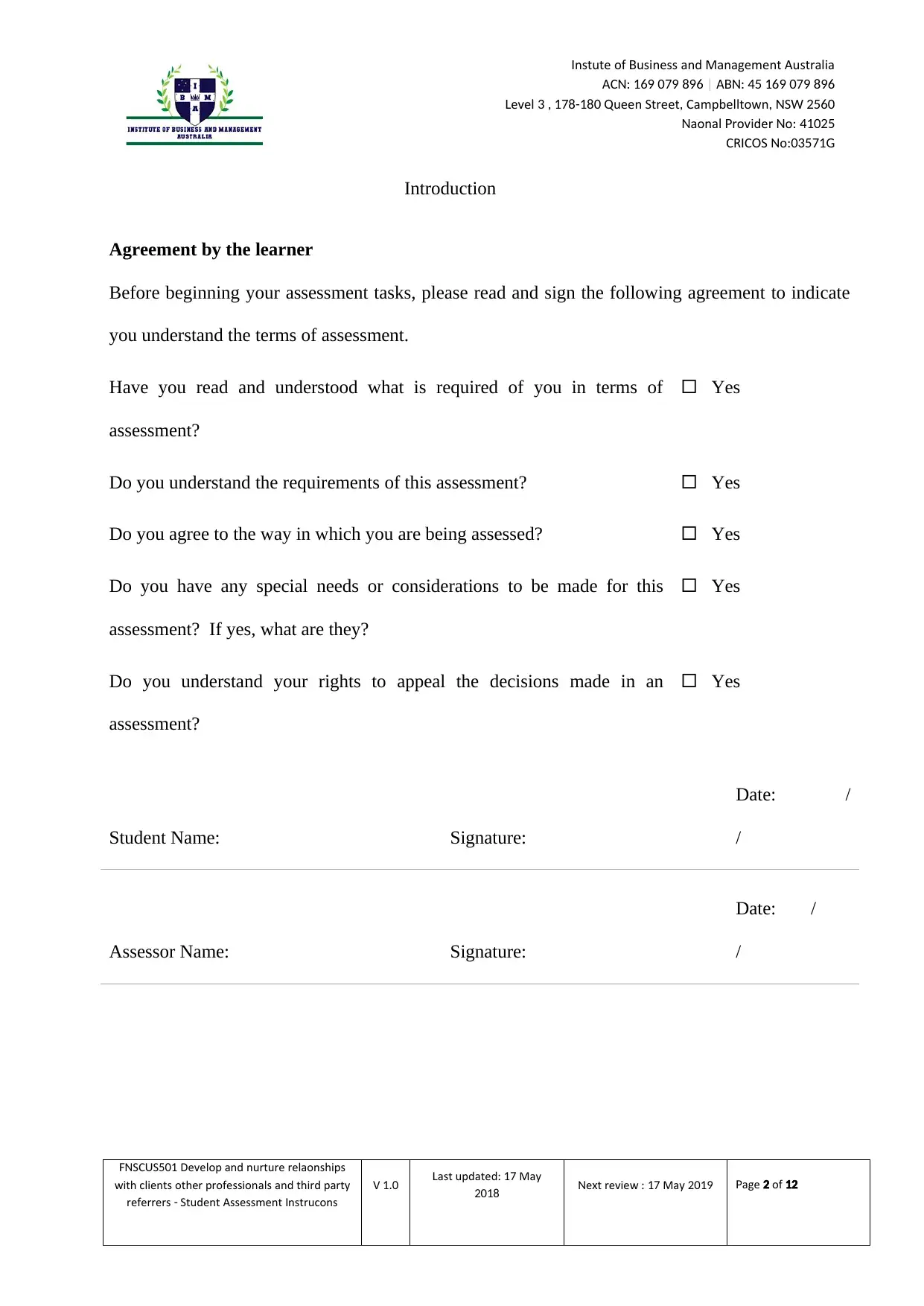
nstitute of usiness and Management AustraliaI B
ACN: 169 079 896 | ABN: 45 169 079 896
evel ueen Street Campbelltown SL 3 , 178-180 Q , , N W 2560
ational rovider oN P N : 41025
CR C S oI O N :03571G
Introduction
Agreement by the learner
Before beginning your assessment tasks, please read and sign the following agreement to indicate
you understand the terms of assessment.
Have you read and understood what is required of you in terms of
assessment?
Yes
Do you understand the requirements of this assessment? Yes
Do you agree to the way in which you are being assessed? Yes
Do you have any special needs or considerations to be made for this
assessment? If yes, what are they?
Yes
Do you understand your rights to appeal the decisions made in an
assessment?
Yes
Student Name: Signature:
Date: /
/
Assessor Name: Signature:
Date: /
/
SC S Develop and nurture relationshipsFN U 501
with clients other professionals and third party
referrers Student Assessment nstructions- I
V 1.0 ast updated MayL : 17
2018 e t review MayN x : 17 2019 ageP 2 of 12
ACN: 169 079 896 | ABN: 45 169 079 896
evel ueen Street Campbelltown SL 3 , 178-180 Q , , N W 2560
ational rovider oN P N : 41025
CR C S oI O N :03571G
Introduction
Agreement by the learner
Before beginning your assessment tasks, please read and sign the following agreement to indicate
you understand the terms of assessment.
Have you read and understood what is required of you in terms of
assessment?
Yes
Do you understand the requirements of this assessment? Yes
Do you agree to the way in which you are being assessed? Yes
Do you have any special needs or considerations to be made for this
assessment? If yes, what are they?
Yes
Do you understand your rights to appeal the decisions made in an
assessment?
Yes
Student Name: Signature:
Date: /
/
Assessor Name: Signature:
Date: /
/
SC S Develop and nurture relationshipsFN U 501
with clients other professionals and third party
referrers Student Assessment nstructions- I
V 1.0 ast updated MayL : 17
2018 e t review MayN x : 17 2019 ageP 2 of 12
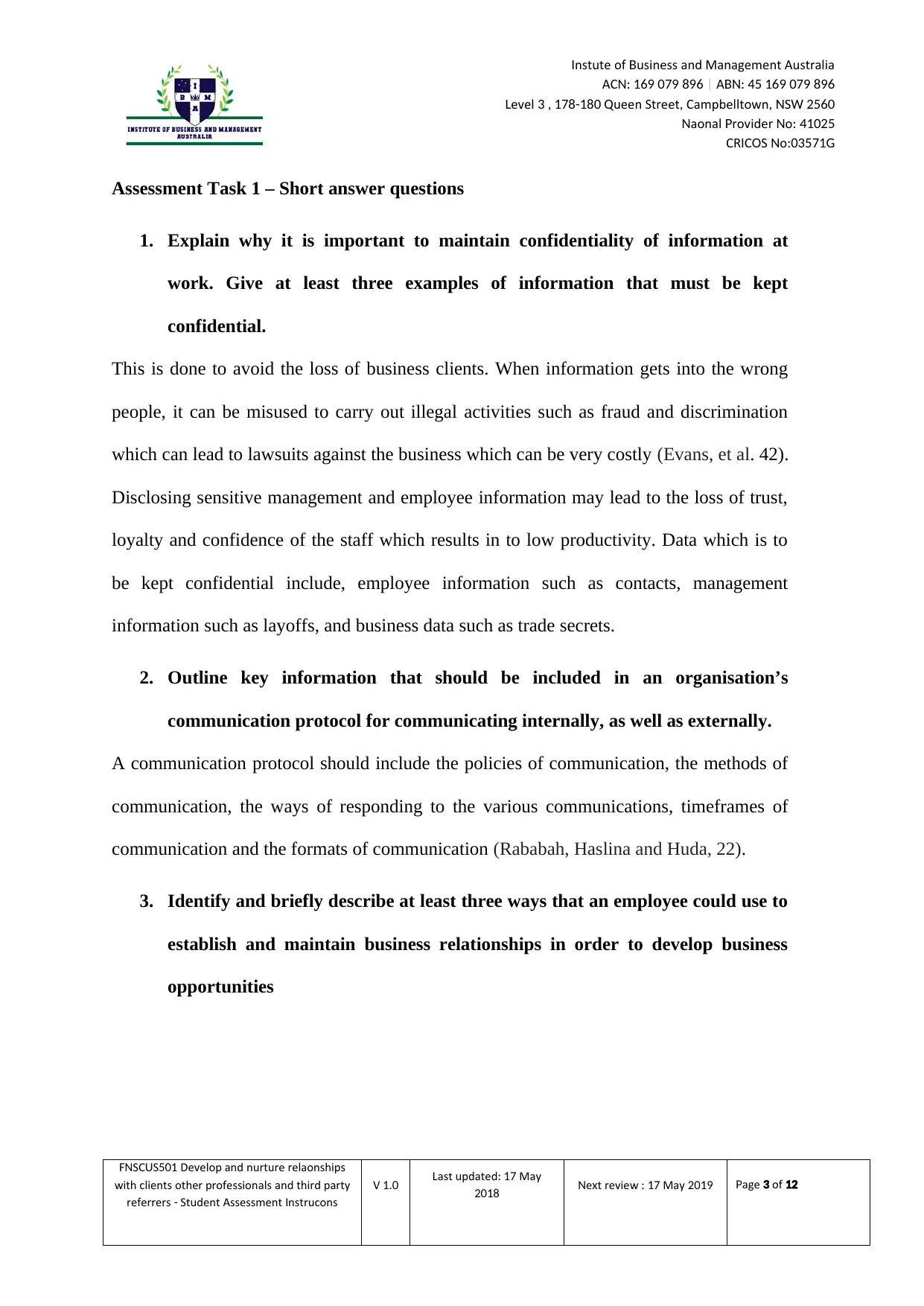
nstitute of usiness and Management AustraliaI B
ACN: 169 079 896 | ABN: 45 169 079 896
evel ueen Street Campbelltown SL 3 , 178-180 Q , , N W 2560
ational rovider oN P N : 41025
CR C S oI O N :03571G
Assessment Task 1 – Short answer questions
1. Explain why it is important to maintain confidentiality of information at
work. Give at least three examples of information that must be kept
confidential.
This is done to avoid the loss of business clients. When information gets into the wrong
people, it can be misused to carry out illegal activities such as fraud and discrimination
which can lead to lawsuits against the business which can be very costly (Evans, et al. 42).
Disclosing sensitive management and employee information may lead to the loss of trust,
loyalty and confidence of the staff which results in to low productivity. Data which is to
be kept confidential include, employee information such as contacts, management
information such as layoffs, and business data such as trade secrets.
2. Outline key information that should be included in an organisation’s
communication protocol for communicating internally, as well as externally.
A communication protocol should include the policies of communication, the methods of
communication, the ways of responding to the various communications, timeframes of
communication and the formats of communication (Rababah, Haslina and Huda, 22).
3. Identify and briefly describe at least three ways that an employee could use to
establish and maintain business relationships in order to develop business
opportunities
SC S Develop and nurture relationshipsFN U 501
with clients other professionals and third party
referrers Student Assessment nstructions- I
V 1.0 ast updated MayL : 17
2018 e t review MayN x : 17 2019 ageP 3 of 12
ACN: 169 079 896 | ABN: 45 169 079 896
evel ueen Street Campbelltown SL 3 , 178-180 Q , , N W 2560
ational rovider oN P N : 41025
CR C S oI O N :03571G
Assessment Task 1 – Short answer questions
1. Explain why it is important to maintain confidentiality of information at
work. Give at least three examples of information that must be kept
confidential.
This is done to avoid the loss of business clients. When information gets into the wrong
people, it can be misused to carry out illegal activities such as fraud and discrimination
which can lead to lawsuits against the business which can be very costly (Evans, et al. 42).
Disclosing sensitive management and employee information may lead to the loss of trust,
loyalty and confidence of the staff which results in to low productivity. Data which is to
be kept confidential include, employee information such as contacts, management
information such as layoffs, and business data such as trade secrets.
2. Outline key information that should be included in an organisation’s
communication protocol for communicating internally, as well as externally.
A communication protocol should include the policies of communication, the methods of
communication, the ways of responding to the various communications, timeframes of
communication and the formats of communication (Rababah, Haslina and Huda, 22).
3. Identify and briefly describe at least three ways that an employee could use to
establish and maintain business relationships in order to develop business
opportunities
SC S Develop and nurture relationshipsFN U 501
with clients other professionals and third party
referrers Student Assessment nstructions- I
V 1.0 ast updated MayL : 17
2018 e t review MayN x : 17 2019 ageP 3 of 12
⊘ This is a preview!⊘
Do you want full access?
Subscribe today to unlock all pages.

Trusted by 1+ million students worldwide
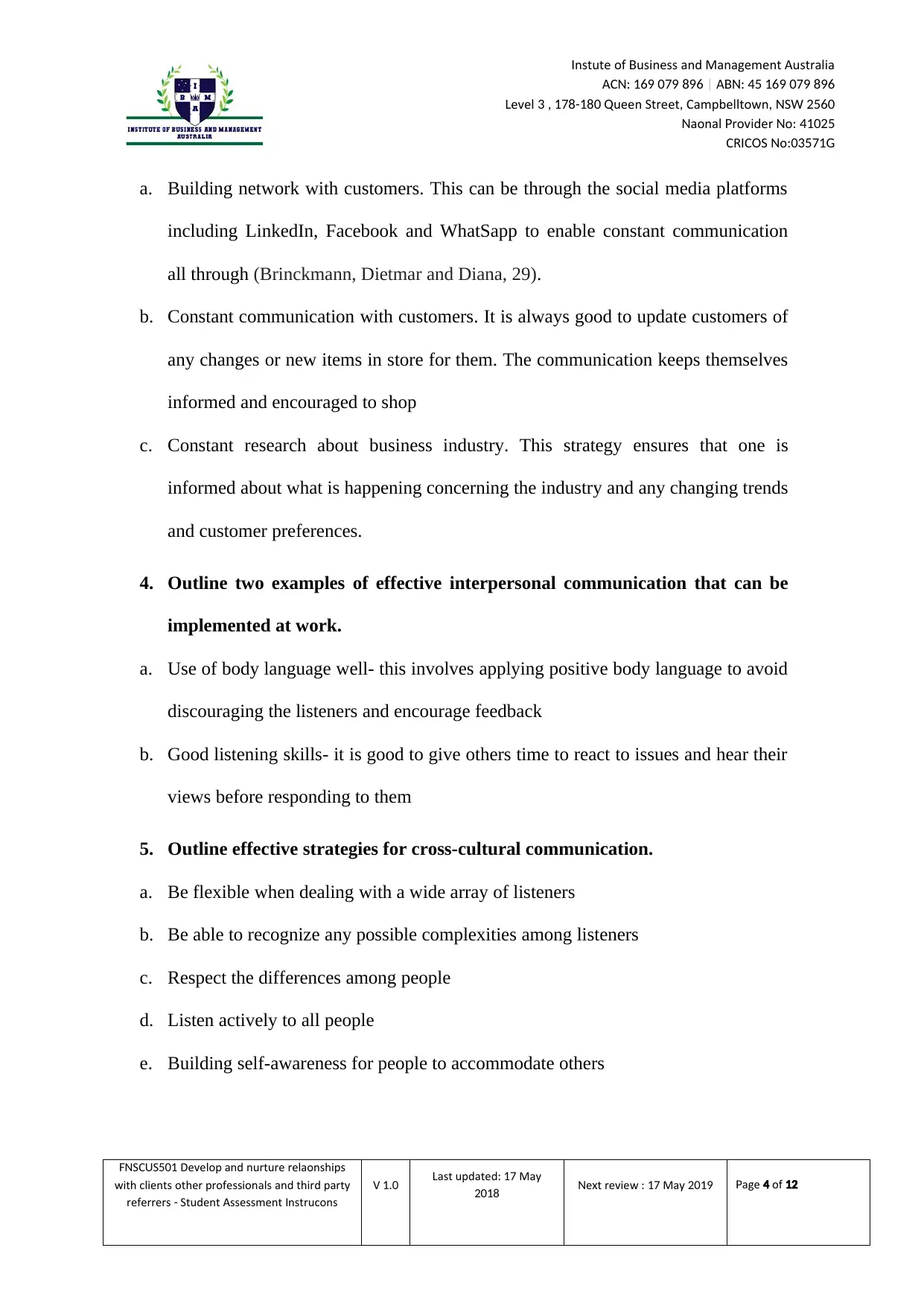
nstitute of usiness and Management AustraliaI B
ACN: 169 079 896 | ABN: 45 169 079 896
evel ueen Street Campbelltown SL 3 , 178-180 Q , , N W 2560
ational rovider oN P N : 41025
CR C S oI O N :03571G
a. Building network with customers. This can be through the social media platforms
including LinkedIn, Facebook and WhatSapp to enable constant communication
all through (Brinckmann, Dietmar and Diana, 29).
b. Constant communication with customers. It is always good to update customers of
any changes or new items in store for them. The communication keeps themselves
informed and encouraged to shop
c. Constant research about business industry. This strategy ensures that one is
informed about what is happening concerning the industry and any changing trends
and customer preferences.
4. Outline two examples of effective interpersonal communication that can be
implemented at work.
a. Use of body language well- this involves applying positive body language to avoid
discouraging the listeners and encourage feedback
b. Good listening skills- it is good to give others time to react to issues and hear their
views before responding to them
5. Outline effective strategies for cross-cultural communication.
a. Be flexible when dealing with a wide array of listeners
b. Be able to recognize any possible complexities among listeners
c. Respect the differences among people
d. Listen actively to all people
e. Building self-awareness for people to accommodate others
SC S Develop and nurture relationshipsFN U 501
with clients other professionals and third party
referrers Student Assessment nstructions- I
V 1.0 ast updated MayL : 17
2018 e t review MayN x : 17 2019 ageP 4 of 12
ACN: 169 079 896 | ABN: 45 169 079 896
evel ueen Street Campbelltown SL 3 , 178-180 Q , , N W 2560
ational rovider oN P N : 41025
CR C S oI O N :03571G
a. Building network with customers. This can be through the social media platforms
including LinkedIn, Facebook and WhatSapp to enable constant communication
all through (Brinckmann, Dietmar and Diana, 29).
b. Constant communication with customers. It is always good to update customers of
any changes or new items in store for them. The communication keeps themselves
informed and encouraged to shop
c. Constant research about business industry. This strategy ensures that one is
informed about what is happening concerning the industry and any changing trends
and customer preferences.
4. Outline two examples of effective interpersonal communication that can be
implemented at work.
a. Use of body language well- this involves applying positive body language to avoid
discouraging the listeners and encourage feedback
b. Good listening skills- it is good to give others time to react to issues and hear their
views before responding to them
5. Outline effective strategies for cross-cultural communication.
a. Be flexible when dealing with a wide array of listeners
b. Be able to recognize any possible complexities among listeners
c. Respect the differences among people
d. Listen actively to all people
e. Building self-awareness for people to accommodate others
SC S Develop and nurture relationshipsFN U 501
with clients other professionals and third party
referrers Student Assessment nstructions- I
V 1.0 ast updated MayL : 17
2018 e t review MayN x : 17 2019 ageP 4 of 12
Paraphrase This Document
Need a fresh take? Get an instant paraphrase of this document with our AI Paraphraser
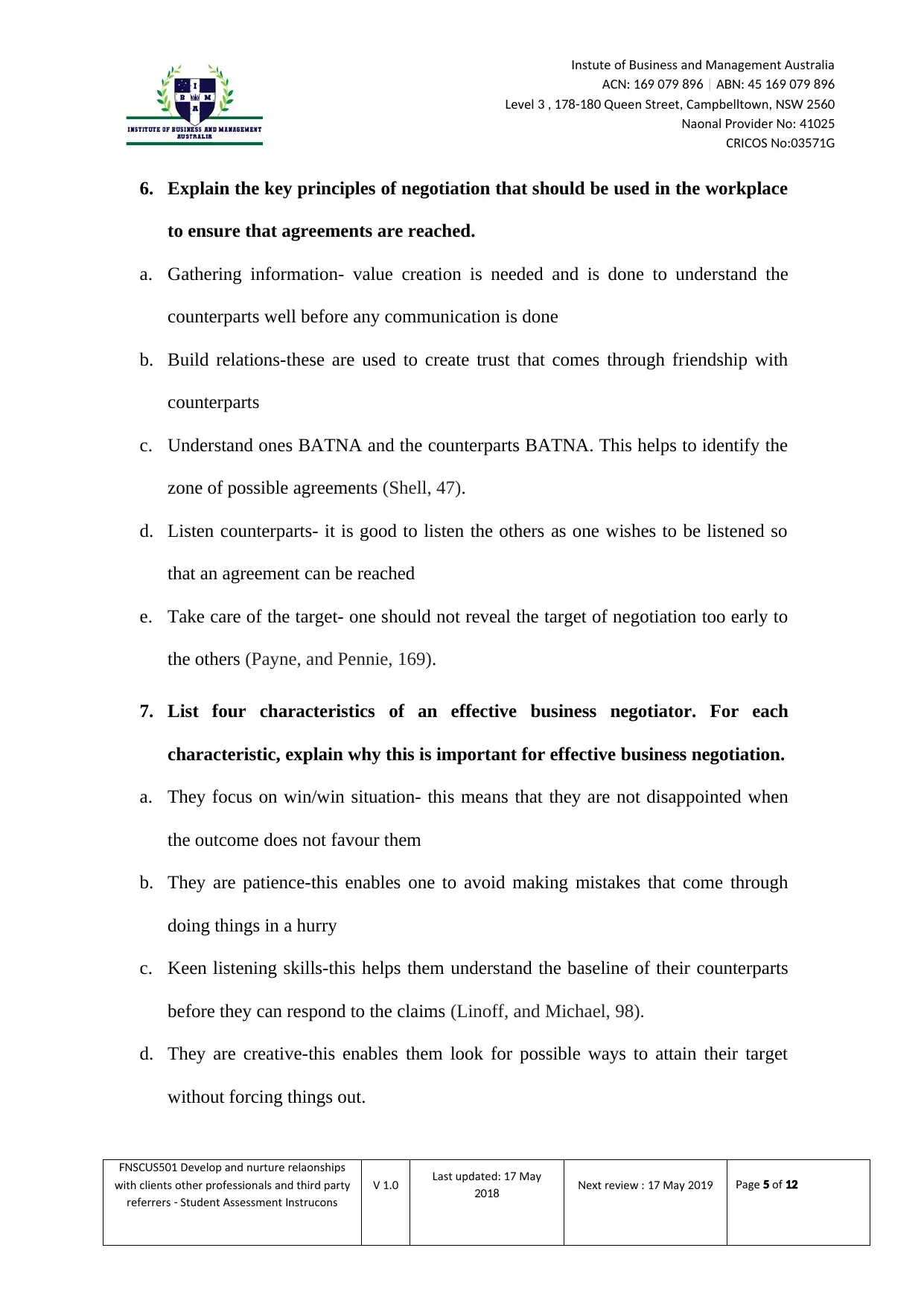
nstitute of usiness and Management AustraliaI B
ACN: 169 079 896 | ABN: 45 169 079 896
evel ueen Street Campbelltown SL 3 , 178-180 Q , , N W 2560
ational rovider oN P N : 41025
CR C S oI O N :03571G
6. Explain the key principles of negotiation that should be used in the workplace
to ensure that agreements are reached.
a. Gathering information- value creation is needed and is done to understand the
counterparts well before any communication is done
b. Build relations-these are used to create trust that comes through friendship with
counterparts
c. Understand ones BATNA and the counterparts BATNA. This helps to identify the
zone of possible agreements (Shell, 47).
d. Listen counterparts- it is good to listen the others as one wishes to be listened so
that an agreement can be reached
e. Take care of the target- one should not reveal the target of negotiation too early to
the others (Payne, and Pennie, 169).
7. List four characteristics of an effective business negotiator. For each
characteristic, explain why this is important for effective business negotiation.
a. They focus on win/win situation- this means that they are not disappointed when
the outcome does not favour them
b. They are patience-this enables one to avoid making mistakes that come through
doing things in a hurry
c. Keen listening skills-this helps them understand the baseline of their counterparts
before they can respond to the claims (Linoff, and Michael, 98).
d. They are creative-this enables them look for possible ways to attain their target
without forcing things out.
SC S Develop and nurture relationshipsFN U 501
with clients other professionals and third party
referrers Student Assessment nstructions- I
V 1.0 ast updated MayL : 17
2018 e t review MayN x : 17 2019 ageP 5 of 12
ACN: 169 079 896 | ABN: 45 169 079 896
evel ueen Street Campbelltown SL 3 , 178-180 Q , , N W 2560
ational rovider oN P N : 41025
CR C S oI O N :03571G
6. Explain the key principles of negotiation that should be used in the workplace
to ensure that agreements are reached.
a. Gathering information- value creation is needed and is done to understand the
counterparts well before any communication is done
b. Build relations-these are used to create trust that comes through friendship with
counterparts
c. Understand ones BATNA and the counterparts BATNA. This helps to identify the
zone of possible agreements (Shell, 47).
d. Listen counterparts- it is good to listen the others as one wishes to be listened so
that an agreement can be reached
e. Take care of the target- one should not reveal the target of negotiation too early to
the others (Payne, and Pennie, 169).
7. List four characteristics of an effective business negotiator. For each
characteristic, explain why this is important for effective business negotiation.
a. They focus on win/win situation- this means that they are not disappointed when
the outcome does not favour them
b. They are patience-this enables one to avoid making mistakes that come through
doing things in a hurry
c. Keen listening skills-this helps them understand the baseline of their counterparts
before they can respond to the claims (Linoff, and Michael, 98).
d. They are creative-this enables them look for possible ways to attain their target
without forcing things out.
SC S Develop and nurture relationshipsFN U 501
with clients other professionals and third party
referrers Student Assessment nstructions- I
V 1.0 ast updated MayL : 17
2018 e t review MayN x : 17 2019 ageP 5 of 12
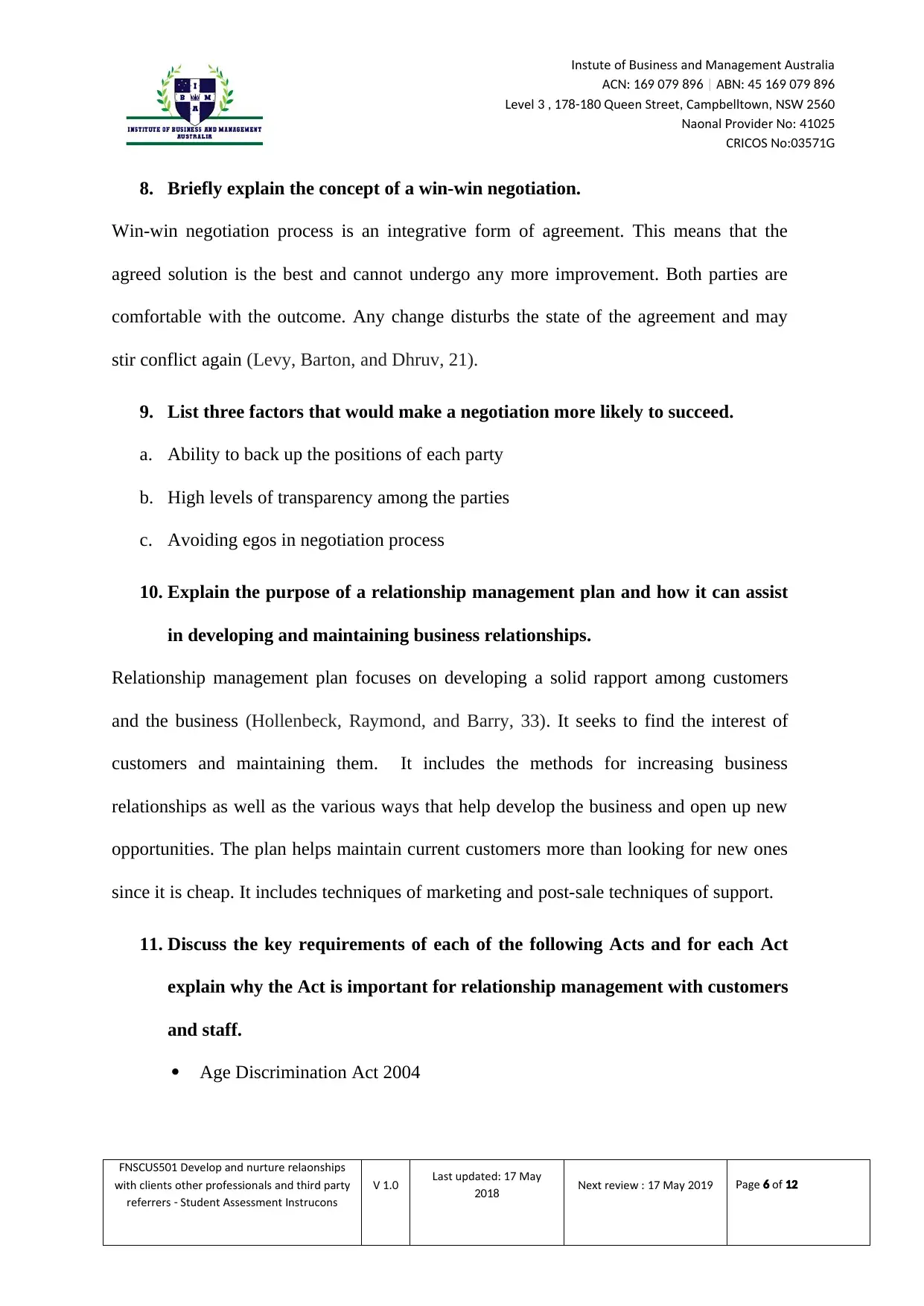
nstitute of usiness and Management AustraliaI B
ACN: 169 079 896 | ABN: 45 169 079 896
evel ueen Street Campbelltown SL 3 , 178-180 Q , , N W 2560
ational rovider oN P N : 41025
CR C S oI O N :03571G
8. Briefly explain the concept of a win-win negotiation.
Win-win negotiation process is an integrative form of agreement. This means that the
agreed solution is the best and cannot undergo any more improvement. Both parties are
comfortable with the outcome. Any change disturbs the state of the agreement and may
stir conflict again (Levy, Barton, and Dhruv, 21).
9. List three factors that would make a negotiation more likely to succeed.
a. Ability to back up the positions of each party
b. High levels of transparency among the parties
c. Avoiding egos in negotiation process
10. Explain the purpose of a relationship management plan and how it can assist
in developing and maintaining business relationships.
Relationship management plan focuses on developing a solid rapport among customers
and the business (Hollenbeck, Raymond, and Barry, 33). It seeks to find the interest of
customers and maintaining them. It includes the methods for increasing business
relationships as well as the various ways that help develop the business and open up new
opportunities. The plan helps maintain current customers more than looking for new ones
since it is cheap. It includes techniques of marketing and post-sale techniques of support.
11. Discuss the key requirements of each of the following Acts and for each Act
explain why the Act is important for relationship management with customers
and staff.
Age Discrimination Act 2004
SC S Develop and nurture relationshipsFN U 501
with clients other professionals and third party
referrers Student Assessment nstructions- I
V 1.0 ast updated MayL : 17
2018 e t review MayN x : 17 2019 ageP 6 of 12
ACN: 169 079 896 | ABN: 45 169 079 896
evel ueen Street Campbelltown SL 3 , 178-180 Q , , N W 2560
ational rovider oN P N : 41025
CR C S oI O N :03571G
8. Briefly explain the concept of a win-win negotiation.
Win-win negotiation process is an integrative form of agreement. This means that the
agreed solution is the best and cannot undergo any more improvement. Both parties are
comfortable with the outcome. Any change disturbs the state of the agreement and may
stir conflict again (Levy, Barton, and Dhruv, 21).
9. List three factors that would make a negotiation more likely to succeed.
a. Ability to back up the positions of each party
b. High levels of transparency among the parties
c. Avoiding egos in negotiation process
10. Explain the purpose of a relationship management plan and how it can assist
in developing and maintaining business relationships.
Relationship management plan focuses on developing a solid rapport among customers
and the business (Hollenbeck, Raymond, and Barry, 33). It seeks to find the interest of
customers and maintaining them. It includes the methods for increasing business
relationships as well as the various ways that help develop the business and open up new
opportunities. The plan helps maintain current customers more than looking for new ones
since it is cheap. It includes techniques of marketing and post-sale techniques of support.
11. Discuss the key requirements of each of the following Acts and for each Act
explain why the Act is important for relationship management with customers
and staff.
Age Discrimination Act 2004
SC S Develop and nurture relationshipsFN U 501
with clients other professionals and third party
referrers Student Assessment nstructions- I
V 1.0 ast updated MayL : 17
2018 e t review MayN x : 17 2019 ageP 6 of 12
⊘ This is a preview!⊘
Do you want full access?
Subscribe today to unlock all pages.

Trusted by 1+ million students worldwide
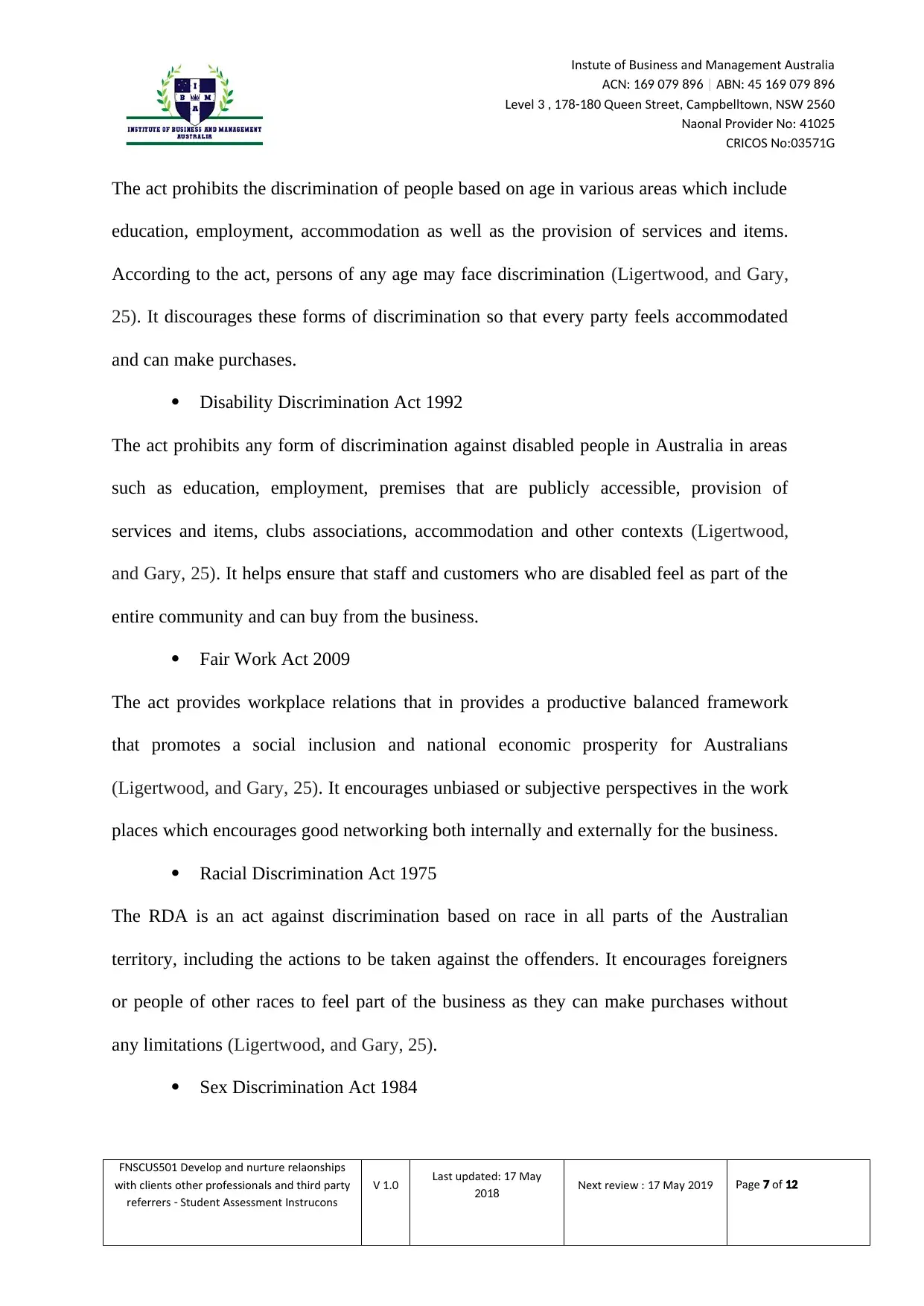
nstitute of usiness and Management AustraliaI B
ACN: 169 079 896 | ABN: 45 169 079 896
evel ueen Street Campbelltown SL 3 , 178-180 Q , , N W 2560
ational rovider oN P N : 41025
CR C S oI O N :03571G
The act prohibits the discrimination of people based on age in various areas which include
education, employment, accommodation as well as the provision of services and items.
According to the act, persons of any age may face discrimination (Ligertwood, and Gary,
25). It discourages these forms of discrimination so that every party feels accommodated
and can make purchases.
Disability Discrimination Act 1992
The act prohibits any form of discrimination against disabled people in Australia in areas
such as education, employment, premises that are publicly accessible, provision of
services and items, clubs associations, accommodation and other contexts (Ligertwood,
and Gary, 25). It helps ensure that staff and customers who are disabled feel as part of the
entire community and can buy from the business.
Fair Work Act 2009
The act provides workplace relations that in provides a productive balanced framework
that promotes a social inclusion and national economic prosperity for Australians
(Ligertwood, and Gary, 25). It encourages unbiased or subjective perspectives in the work
places which encourages good networking both internally and externally for the business.
Racial Discrimination Act 1975
The RDA is an act against discrimination based on race in all parts of the Australian
territory, including the actions to be taken against the offenders. It encourages foreigners
or people of other races to feel part of the business as they can make purchases without
any limitations (Ligertwood, and Gary, 25).
Sex Discrimination Act 1984
SC S Develop and nurture relationshipsFN U 501
with clients other professionals and third party
referrers Student Assessment nstructions- I
V 1.0 ast updated MayL : 17
2018 e t review MayN x : 17 2019 ageP 7 of 12
ACN: 169 079 896 | ABN: 45 169 079 896
evel ueen Street Campbelltown SL 3 , 178-180 Q , , N W 2560
ational rovider oN P N : 41025
CR C S oI O N :03571G
The act prohibits the discrimination of people based on age in various areas which include
education, employment, accommodation as well as the provision of services and items.
According to the act, persons of any age may face discrimination (Ligertwood, and Gary,
25). It discourages these forms of discrimination so that every party feels accommodated
and can make purchases.
Disability Discrimination Act 1992
The act prohibits any form of discrimination against disabled people in Australia in areas
such as education, employment, premises that are publicly accessible, provision of
services and items, clubs associations, accommodation and other contexts (Ligertwood,
and Gary, 25). It helps ensure that staff and customers who are disabled feel as part of the
entire community and can buy from the business.
Fair Work Act 2009
The act provides workplace relations that in provides a productive balanced framework
that promotes a social inclusion and national economic prosperity for Australians
(Ligertwood, and Gary, 25). It encourages unbiased or subjective perspectives in the work
places which encourages good networking both internally and externally for the business.
Racial Discrimination Act 1975
The RDA is an act against discrimination based on race in all parts of the Australian
territory, including the actions to be taken against the offenders. It encourages foreigners
or people of other races to feel part of the business as they can make purchases without
any limitations (Ligertwood, and Gary, 25).
Sex Discrimination Act 1984
SC S Develop and nurture relationshipsFN U 501
with clients other professionals and third party
referrers Student Assessment nstructions- I
V 1.0 ast updated MayL : 17
2018 e t review MayN x : 17 2019 ageP 7 of 12
Paraphrase This Document
Need a fresh take? Get an instant paraphrase of this document with our AI Paraphraser
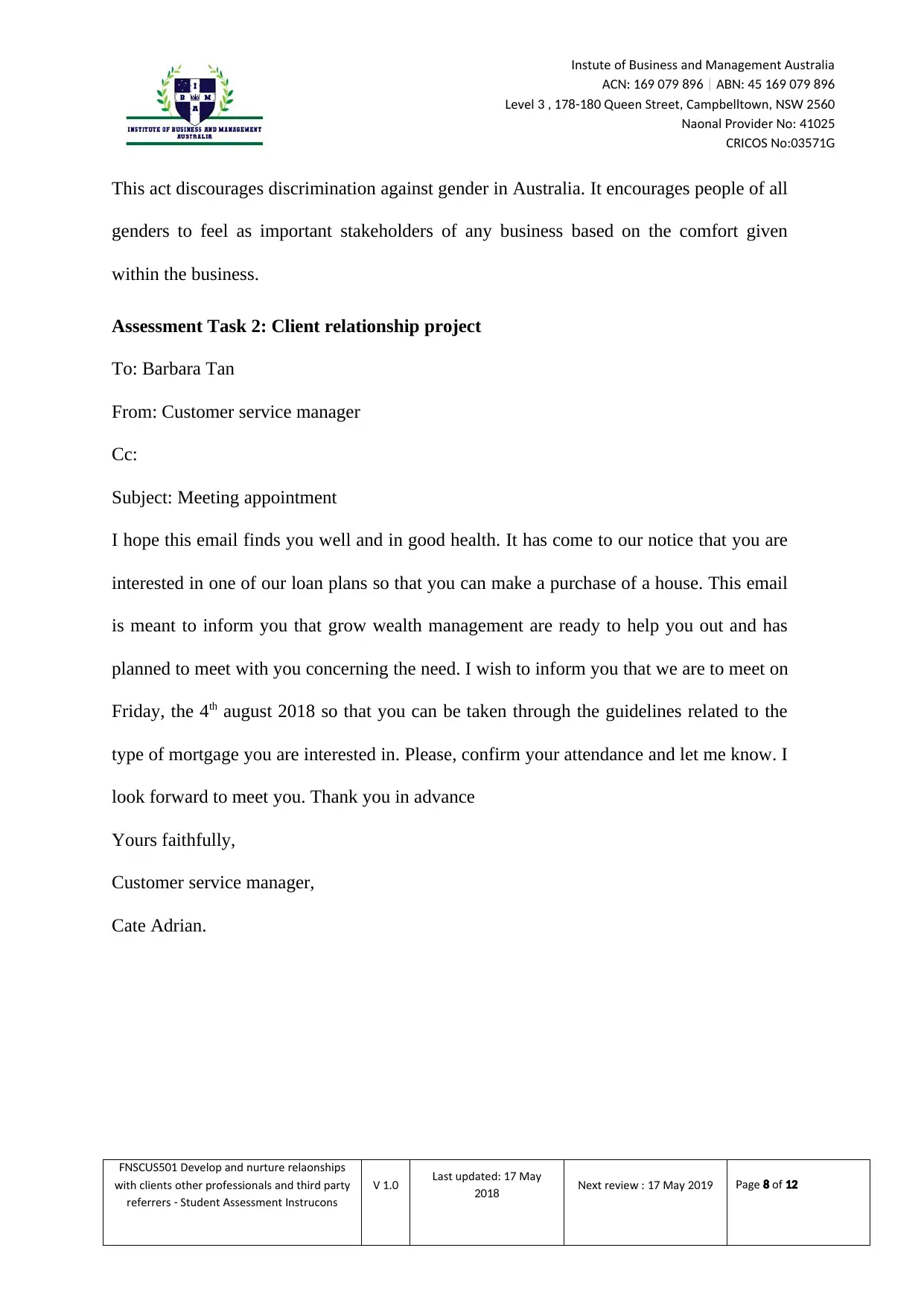
nstitute of usiness and Management AustraliaI B
ACN: 169 079 896 | ABN: 45 169 079 896
evel ueen Street Campbelltown SL 3 , 178-180 Q , , N W 2560
ational rovider oN P N : 41025
CR C S oI O N :03571G
This act discourages discrimination against gender in Australia. It encourages people of all
genders to feel as important stakeholders of any business based on the comfort given
within the business.
Assessment Task 2: Client relationship project
To: Barbara Tan
From: Customer service manager
Cc:
Subject: Meeting appointment
I hope this email finds you well and in good health. It has come to our notice that you are
interested in one of our loan plans so that you can make a purchase of a house. This email
is meant to inform you that grow wealth management are ready to help you out and has
planned to meet with you concerning the need. I wish to inform you that we are to meet on
Friday, the 4th august 2018 so that you can be taken through the guidelines related to the
type of mortgage you are interested in. Please, confirm your attendance and let me know. I
look forward to meet you. Thank you in advance
Yours faithfully,
Customer service manager,
Cate Adrian.
SC S Develop and nurture relationshipsFN U 501
with clients other professionals and third party
referrers Student Assessment nstructions- I
V 1.0 ast updated MayL : 17
2018 e t review MayN x : 17 2019 ageP 8 of 12
ACN: 169 079 896 | ABN: 45 169 079 896
evel ueen Street Campbelltown SL 3 , 178-180 Q , , N W 2560
ational rovider oN P N : 41025
CR C S oI O N :03571G
This act discourages discrimination against gender in Australia. It encourages people of all
genders to feel as important stakeholders of any business based on the comfort given
within the business.
Assessment Task 2: Client relationship project
To: Barbara Tan
From: Customer service manager
Cc:
Subject: Meeting appointment
I hope this email finds you well and in good health. It has come to our notice that you are
interested in one of our loan plans so that you can make a purchase of a house. This email
is meant to inform you that grow wealth management are ready to help you out and has
planned to meet with you concerning the need. I wish to inform you that we are to meet on
Friday, the 4th august 2018 so that you can be taken through the guidelines related to the
type of mortgage you are interested in. Please, confirm your attendance and let me know. I
look forward to meet you. Thank you in advance
Yours faithfully,
Customer service manager,
Cate Adrian.
SC S Develop and nurture relationshipsFN U 501
with clients other professionals and third party
referrers Student Assessment nstructions- I
V 1.0 ast updated MayL : 17
2018 e t review MayN x : 17 2019 ageP 8 of 12
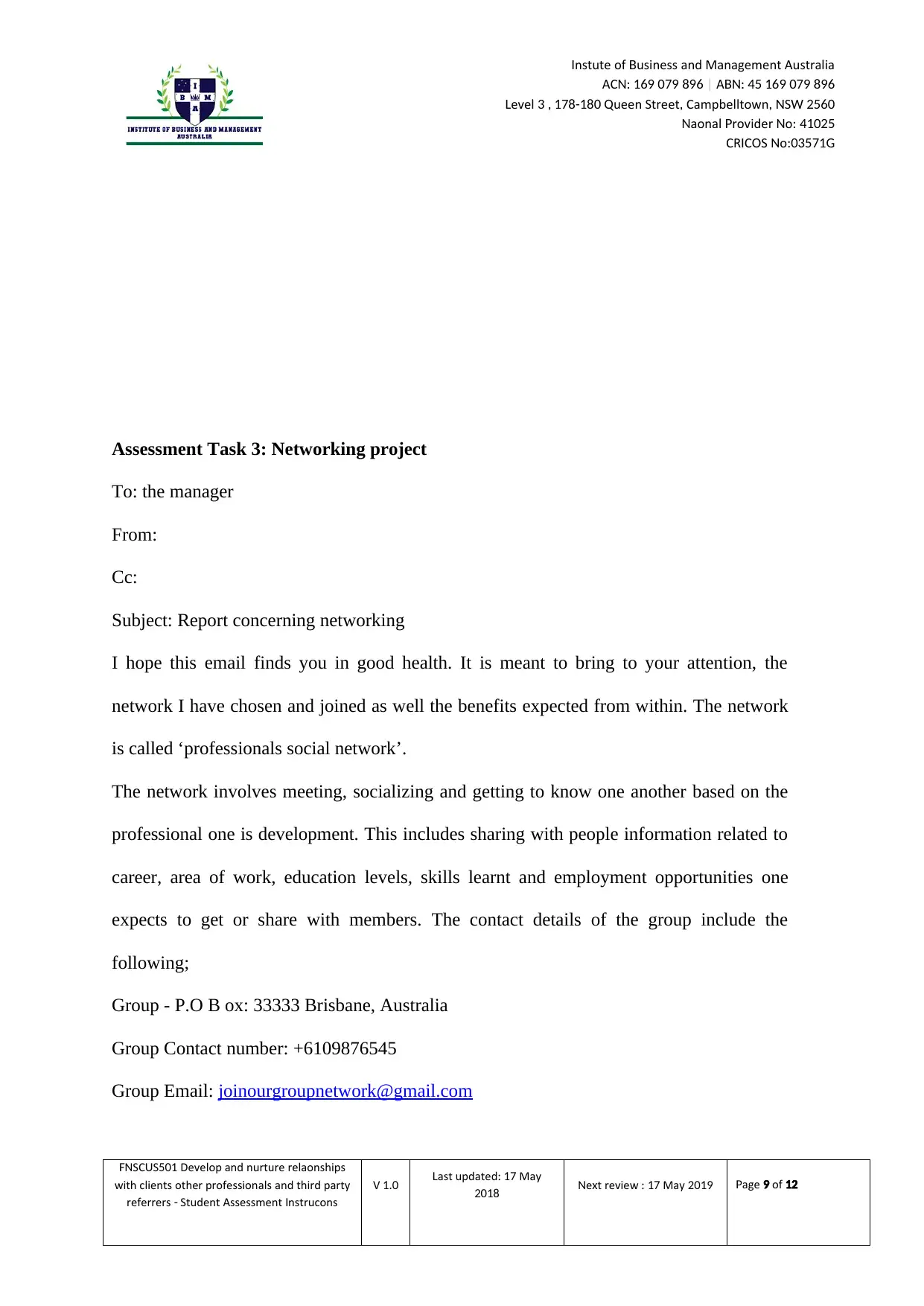
nstitute of usiness and Management AustraliaI B
ACN: 169 079 896 | ABN: 45 169 079 896
evel ueen Street Campbelltown SL 3 , 178-180 Q , , N W 2560
ational rovider oN P N : 41025
CR C S oI O N :03571G
Assessment Task 3: Networking project
To: the manager
From:
Cc:
Subject: Report concerning networking
I hope this email finds you in good health. It is meant to bring to your attention, the
network I have chosen and joined as well the benefits expected from within. The network
is called ‘professionals social network’.
The network involves meeting, socializing and getting to know one another based on the
professional one is development. This includes sharing with people information related to
career, area of work, education levels, skills learnt and employment opportunities one
expects to get or share with members. The contact details of the group include the
following;
Group - P.O B ox: 33333 Brisbane, Australia
Group Contact number: +6109876545
Group Email: joinourgroupnetwork@gmail.com
SC S Develop and nurture relationshipsFN U 501
with clients other professionals and third party
referrers Student Assessment nstructions- I
V 1.0 ast updated MayL : 17
2018 e t review MayN x : 17 2019 ageP 9 of 12
ACN: 169 079 896 | ABN: 45 169 079 896
evel ueen Street Campbelltown SL 3 , 178-180 Q , , N W 2560
ational rovider oN P N : 41025
CR C S oI O N :03571G
Assessment Task 3: Networking project
To: the manager
From:
Cc:
Subject: Report concerning networking
I hope this email finds you in good health. It is meant to bring to your attention, the
network I have chosen and joined as well the benefits expected from within. The network
is called ‘professionals social network’.
The network involves meeting, socializing and getting to know one another based on the
professional one is development. This includes sharing with people information related to
career, area of work, education levels, skills learnt and employment opportunities one
expects to get or share with members. The contact details of the group include the
following;
Group - P.O B ox: 33333 Brisbane, Australia
Group Contact number: +6109876545
Group Email: joinourgroupnetwork@gmail.com
SC S Develop and nurture relationshipsFN U 501
with clients other professionals and third party
referrers Student Assessment nstructions- I
V 1.0 ast updated MayL : 17
2018 e t review MayN x : 17 2019 ageP 9 of 12
⊘ This is a preview!⊘
Do you want full access?
Subscribe today to unlock all pages.

Trusted by 1+ million students worldwide
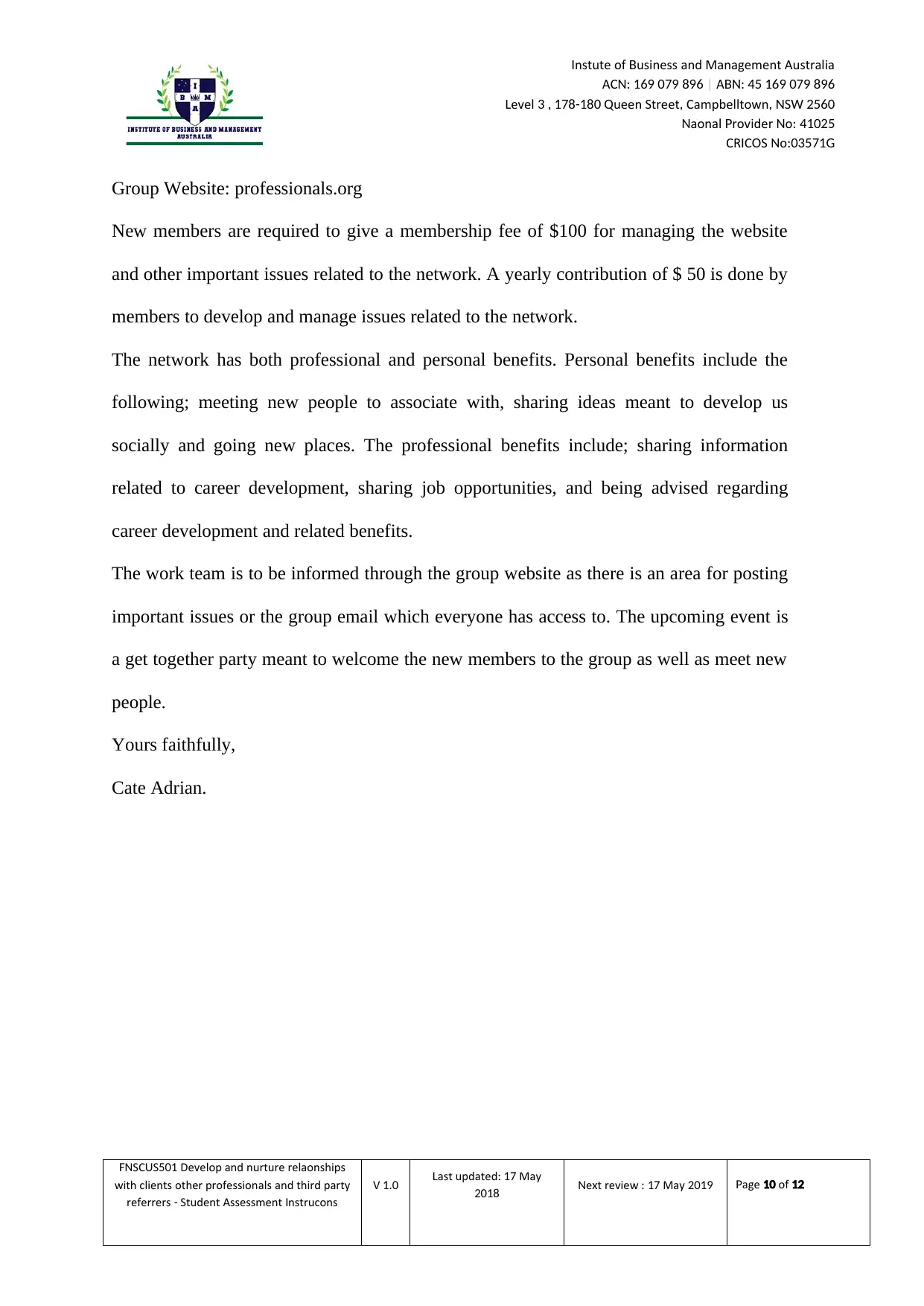
nstitute of usiness and Management AustraliaI B
ACN: 169 079 896 | ABN: 45 169 079 896
evel ueen Street Campbelltown SL 3 , 178-180 Q , , N W 2560
ational rovider oN P N : 41025
CR C S oI O N :03571G
Group Website: professionals.org
New members are required to give a membership fee of $100 for managing the website
and other important issues related to the network. A yearly contribution of $ 50 is done by
members to develop and manage issues related to the network.
The network has both professional and personal benefits. Personal benefits include the
following; meeting new people to associate with, sharing ideas meant to develop us
socially and going new places. The professional benefits include; sharing information
related to career development, sharing job opportunities, and being advised regarding
career development and related benefits.
The work team is to be informed through the group website as there is an area for posting
important issues or the group email which everyone has access to. The upcoming event is
a get together party meant to welcome the new members to the group as well as meet new
people.
Yours faithfully,
Cate Adrian.
SC S Develop and nurture relationshipsFN U 501
with clients other professionals and third party
referrers Student Assessment nstructions- I
V 1.0 ast updated MayL : 17
2018 e t review MayN x : 17 2019 ageP 10 of 12
ACN: 169 079 896 | ABN: 45 169 079 896
evel ueen Street Campbelltown SL 3 , 178-180 Q , , N W 2560
ational rovider oN P N : 41025
CR C S oI O N :03571G
Group Website: professionals.org
New members are required to give a membership fee of $100 for managing the website
and other important issues related to the network. A yearly contribution of $ 50 is done by
members to develop and manage issues related to the network.
The network has both professional and personal benefits. Personal benefits include the
following; meeting new people to associate with, sharing ideas meant to develop us
socially and going new places. The professional benefits include; sharing information
related to career development, sharing job opportunities, and being advised regarding
career development and related benefits.
The work team is to be informed through the group website as there is an area for posting
important issues or the group email which everyone has access to. The upcoming event is
a get together party meant to welcome the new members to the group as well as meet new
people.
Yours faithfully,
Cate Adrian.
SC S Develop and nurture relationshipsFN U 501
with clients other professionals and third party
referrers Student Assessment nstructions- I
V 1.0 ast updated MayL : 17
2018 e t review MayN x : 17 2019 ageP 10 of 12
Paraphrase This Document
Need a fresh take? Get an instant paraphrase of this document with our AI Paraphraser
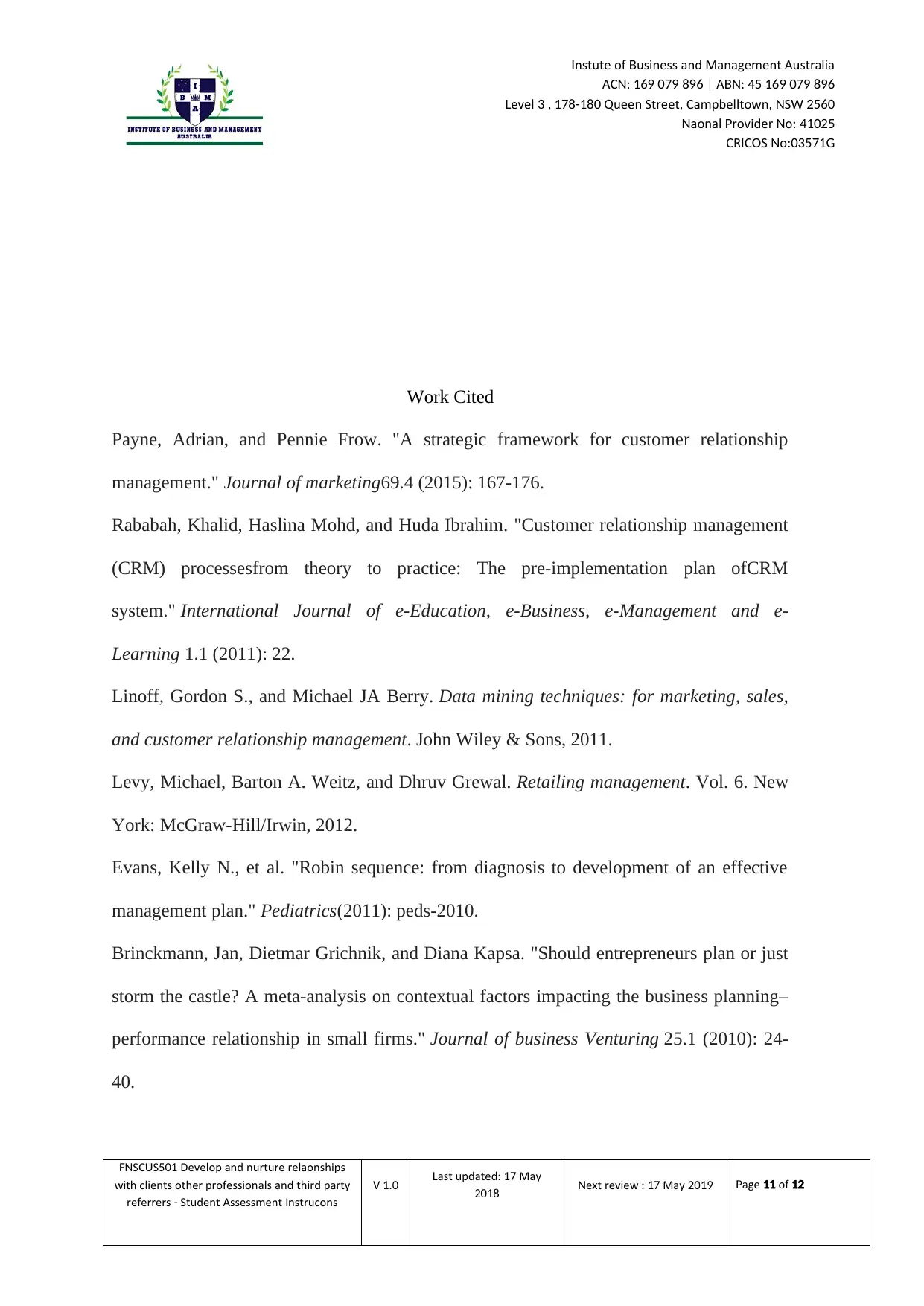
nstitute of usiness and Management AustraliaI B
ACN: 169 079 896 | ABN: 45 169 079 896
evel ueen Street Campbelltown SL 3 , 178-180 Q , , N W 2560
ational rovider oN P N : 41025
CR C S oI O N :03571G
Work Cited
Payne, Adrian, and Pennie Frow. "A strategic framework for customer relationship
management." Journal of marketing69.4 (2015): 167-176.
Rababah, Khalid, Haslina Mohd, and Huda Ibrahim. "Customer relationship management
(CRM) processesfrom theory to practice: The pre-implementation plan ofCRM
system." International Journal of e-Education, e-Business, e-Management and e-
Learning 1.1 (2011): 22.
Linoff, Gordon S., and Michael JA Berry. Data mining techniques: for marketing, sales,
and customer relationship management. John Wiley & Sons, 2011.
Levy, Michael, Barton A. Weitz, and Dhruv Grewal. Retailing management. Vol. 6. New
York: McGraw-Hill/Irwin, 2012.
Evans, Kelly N., et al. "Robin sequence: from diagnosis to development of an effective
management plan." Pediatrics(2011): peds-2010.
Brinckmann, Jan, Dietmar Grichnik, and Diana Kapsa. "Should entrepreneurs plan or just
storm the castle? A meta-analysis on contextual factors impacting the business planning–
performance relationship in small firms." Journal of business Venturing 25.1 (2010): 24-
40.
SC S Develop and nurture relationshipsFN U 501
with clients other professionals and third party
referrers Student Assessment nstructions- I
V 1.0 ast updated MayL : 17
2018 e t review MayN x : 17 2019 ageP 11 of 12
ACN: 169 079 896 | ABN: 45 169 079 896
evel ueen Street Campbelltown SL 3 , 178-180 Q , , N W 2560
ational rovider oN P N : 41025
CR C S oI O N :03571G
Work Cited
Payne, Adrian, and Pennie Frow. "A strategic framework for customer relationship
management." Journal of marketing69.4 (2015): 167-176.
Rababah, Khalid, Haslina Mohd, and Huda Ibrahim. "Customer relationship management
(CRM) processesfrom theory to practice: The pre-implementation plan ofCRM
system." International Journal of e-Education, e-Business, e-Management and e-
Learning 1.1 (2011): 22.
Linoff, Gordon S., and Michael JA Berry. Data mining techniques: for marketing, sales,
and customer relationship management. John Wiley & Sons, 2011.
Levy, Michael, Barton A. Weitz, and Dhruv Grewal. Retailing management. Vol. 6. New
York: McGraw-Hill/Irwin, 2012.
Evans, Kelly N., et al. "Robin sequence: from diagnosis to development of an effective
management plan." Pediatrics(2011): peds-2010.
Brinckmann, Jan, Dietmar Grichnik, and Diana Kapsa. "Should entrepreneurs plan or just
storm the castle? A meta-analysis on contextual factors impacting the business planning–
performance relationship in small firms." Journal of business Venturing 25.1 (2010): 24-
40.
SC S Develop and nurture relationshipsFN U 501
with clients other professionals and third party
referrers Student Assessment nstructions- I
V 1.0 ast updated MayL : 17
2018 e t review MayN x : 17 2019 ageP 11 of 12
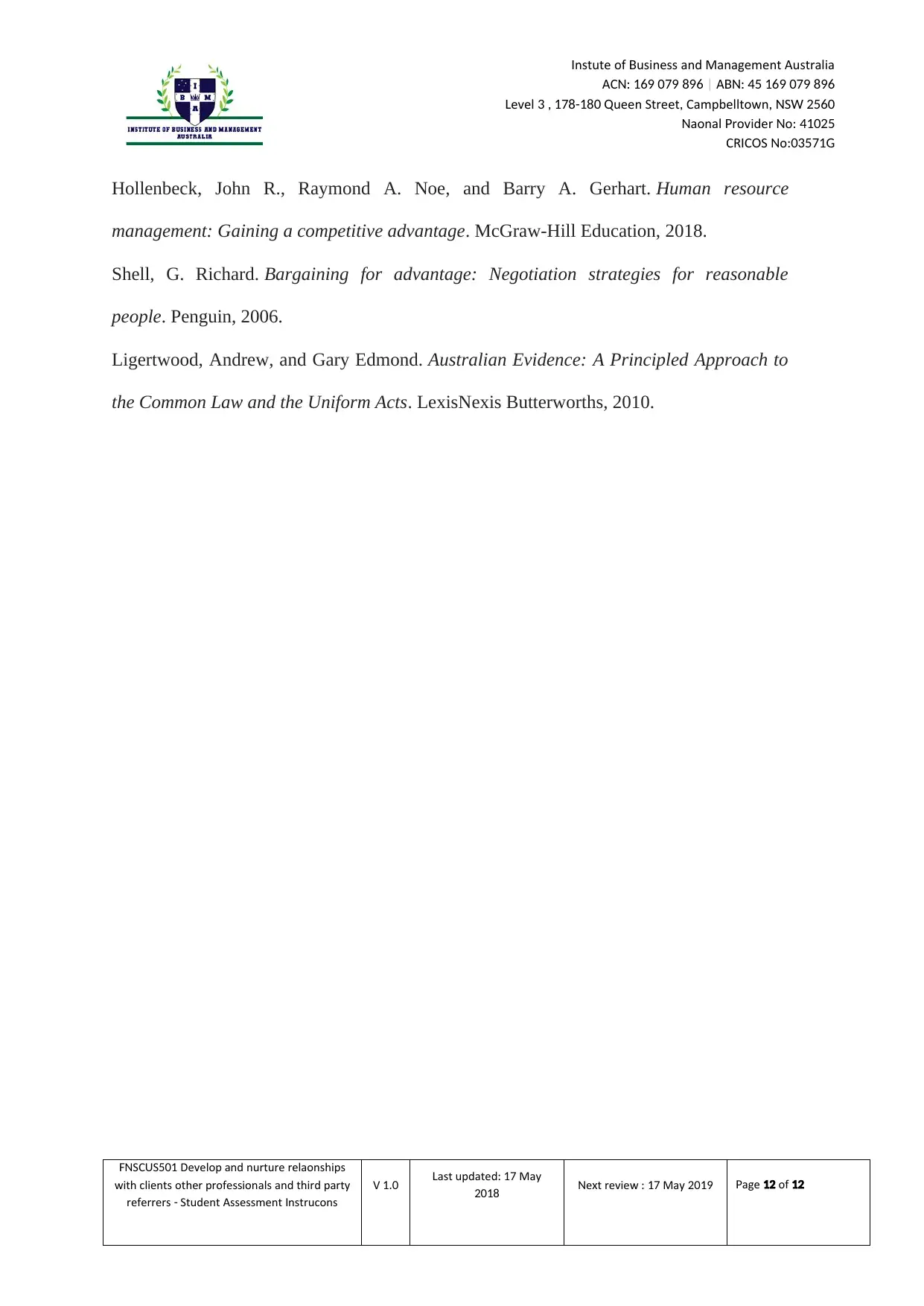
nstitute of usiness and Management AustraliaI B
ACN: 169 079 896 | ABN: 45 169 079 896
evel ueen Street Campbelltown SL 3 , 178-180 Q , , N W 2560
ational rovider oN P N : 41025
CR C S oI O N :03571G
Hollenbeck, John R., Raymond A. Noe, and Barry A. Gerhart. Human resource
management: Gaining a competitive advantage. McGraw-Hill Education, 2018.
Shell, G. Richard. Bargaining for advantage: Negotiation strategies for reasonable
people. Penguin, 2006.
Ligertwood, Andrew, and Gary Edmond. Australian Evidence: A Principled Approach to
the Common Law and the Uniform Acts. LexisNexis Butterworths, 2010.
SC S Develop and nurture relationshipsFN U 501
with clients other professionals and third party
referrers Student Assessment nstructions- I
V 1.0 ast updated MayL : 17
2018 e t review MayN x : 17 2019 ageP 12 of 12
ACN: 169 079 896 | ABN: 45 169 079 896
evel ueen Street Campbelltown SL 3 , 178-180 Q , , N W 2560
ational rovider oN P N : 41025
CR C S oI O N :03571G
Hollenbeck, John R., Raymond A. Noe, and Barry A. Gerhart. Human resource
management: Gaining a competitive advantage. McGraw-Hill Education, 2018.
Shell, G. Richard. Bargaining for advantage: Negotiation strategies for reasonable
people. Penguin, 2006.
Ligertwood, Andrew, and Gary Edmond. Australian Evidence: A Principled Approach to
the Common Law and the Uniform Acts. LexisNexis Butterworths, 2010.
SC S Develop and nurture relationshipsFN U 501
with clients other professionals and third party
referrers Student Assessment nstructions- I
V 1.0 ast updated MayL : 17
2018 e t review MayN x : 17 2019 ageP 12 of 12
⊘ This is a preview!⊘
Do you want full access?
Subscribe today to unlock all pages.

Trusted by 1+ million students worldwide
1 out of 12
Your All-in-One AI-Powered Toolkit for Academic Success.
+13062052269
info@desklib.com
Available 24*7 on WhatsApp / Email
![[object Object]](/_next/static/media/star-bottom.7253800d.svg)
Unlock your academic potential
Copyright © 2020–2025 A2Z Services. All Rights Reserved. Developed and managed by ZUCOL.